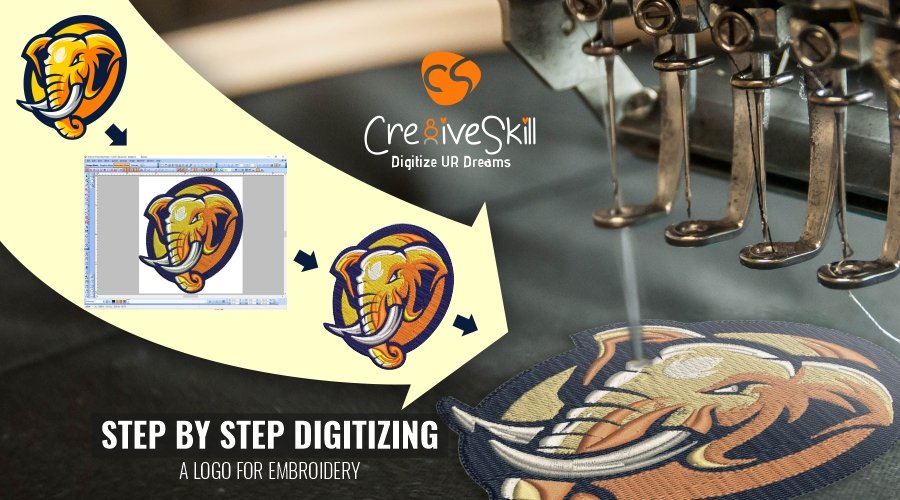Economical Digitizing for Embroidery: Precision and Detail
Economical Digitizing for Embroidery: Precision and Detail
Blog Article
Streamlining the Art of Embroidery Digitizing: Step-by-Step Guide
As technology proceeds to development, the digitization process has ended up being much more obtainable, permitting enthusiasts to bring their detailed designs to life with ease. In this overview, we will certainly untangle the intricacies of needlework digitizing, damaging down each step carefully to improve the process and equip both novices and experienced embroiderers alike.
Comprehending Needlework Digitizing Software Program
Needlework digitizing software program acts as a vital device for transforming complex styles into digital formats suitable with embroidery devices, promoting precise sewing and personalization. This specialized software program enables users to import different photo file layouts, such as JPG or PNG, and transform them into embroidery machine-readable layouts like DST, EXP, or PES - Digitizing for Embroidery. By utilizing functions like stitch modifying, rug options, and string shade option, digitizing software application enables users to regulate every element of the layout process
Additionally, progressed needlework digitizing software application supplies devices for developing intricate layouts, changing stitch thickness, and integrating detailed information. Users can also sneak peek the design before sewing it out, guaranteeing precision and lessening errors. Furthermore, several software application offer automatic functions that assist simplify the digitizing procedure, conserving time and effort.
Comprehending the abilities of embroidery digitizing software is vital for achieving high-quality outcomes in embroidery projects. By grasping this device, needlework enthusiasts and specialists can release their imagination and bring complex layouts to life with accuracy and efficiency.

Selecting the Right Style Data
After acquainting yourself with the abilities of embroidery digitizing software program, the following essential step in the process is selecting the best design data for your project. Digitizing for Embroidery. When choosing a design documents for needlework digitizing, it's vital to think about the complexity of the layout, the dimension of the end product, and the sort of textile you will certainly be collaborating with
For detailed designs with great details, a high-resolution photo or vector data is recommended to make sure that the embroidery maker can precisely reproduce the layout. Additionally, the size of the end product plays a significant duty in picking the ideal design documents. Larger layouts might call for higher resolution data to maintain clearness and sharpness.
Additionally, the kind of textile you will certainly be stitching on affects the choice of style data. Different textiles might require changes in the style documents to make sure that the stitches are appropriately lined up and the layout appears as meant. By very carefully choosing the appropriate layout data based upon these factors, you can set on your own up for an effective embroidery digitizing process.
Digitizing Tools and Strategies
Using specialized software application and precision strategies, digitizing devices are vital in transforming detailed styles into embroidery-ready documents. Needlework digitizing software program, such as Wilcom, Hatch, or article Embrilliance, gives the required platform to transform artwork right into stitch information. These programs use attributes like stitch editing and enhancing, padding choices, and text tools to make sure the design translates effortlessly onto fabric.
One of the crucial techniques in digitizing is developing a clear path for the embroidery machine to adhere to. This involves digitizing each element of the layout with accuracy, identifying stitch kinds, thickness, and directions. By utilizing devices like digitizing tablet computers or software-specific plugins, embroiderers can achieve a high level of precision in their digitized layouts.
Furthermore, understanding the art of underlay stitching is vital for generating top quality embroidery. Underlay stitching supports the fabric and develops a structure for the layout, ensuring that the final product is both aesthetically appealing and resilient. By understanding these digitizing devices and strategies, embroiderers can boost their craft and bring complex layouts to life with accuracy and effectiveness.
Personalizing Stitch Kinds and Directions
The option of stitch kinds can significantly impact the general appearance and structure of the stitched style. By purposefully integrating these stitch kinds, embroiderers can achieve depth and dimension in their styles.
In Read Full Report addition, the instructions of stitches plays a crucial function in enhancing the aesthetic charm of the last needlework. By exploring with different stitch angles and patterns, embroiderers can bring their layouts to life with amazing information and complexity.
Testing and Refining Your Digitized Layout
To make sure the precision and top quality of your digitized style, extensive screening and improvement are crucial steps in the embroidery digitizing procedure. Once you have completed the digitization of your style, it is crucial to check it before waging the real needlework. Testing permits you to recognize any prospective issues such as thread breaks, stitch density problems, or layout distortions that may affect the outcome.

After screening, it is essential to fine-tune your digitized style based on the responses from the test sew-out. This may involve tweaking stitch setups, changing densities, or making modifications to the overall layout to attain the wanted result. By repeating through testing and improvement, you can adjust your digitized style to excellence before moving forward with the actual embroidery procedure.
Final Thought
To conclude, understanding the art of needlework digitizing calls for a comprehensive understanding of the software, choosing the right style documents, making use of digitizing tools and methods, tailoring stitch kinds and directions, and testing and refining the digitized style. By following these actions, embroiderers can simplify the digitizing procedure and develop high-quality stitched layouts with precision and effectiveness.
Report this page